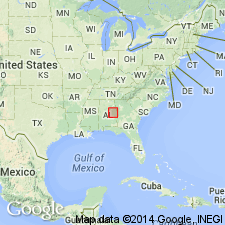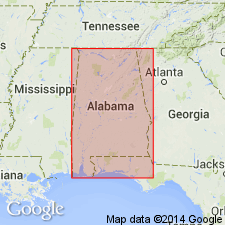
- Usage in publication:
-
- Hanover Schist
- Modifications:
-
- Named
- Dominant lithology:
-
- Schist
- Gneiss
- AAPG geologic province:
-
- Piedmont-Blue Ridge province
Summary:
Hanover Schist of Hatchet Creek Group named in east-central AL. Consists of quartz muscovite schist and staurolite biotite feldspathic gneiss. Structurally underlies Wedowee Group in northeastern Coosa Co. Age is early to middle Paleozoic.
Source: GNU records (USGS DDS-6; Reston GNULEX).

- Usage in publication:
-
- Hanover Schist
- Modifications:
-
- Overview
- AAPG geologic province:
-
- Piedmont-Blue Ridge province
Summary:
Hanover Schist of Hatchet Creek Group is an interbedded sequence of coarse- to fine-grained (staurolite+/-)-albite-biotite-sericite-quartz-muscovite schist and (staurolite+/-)-biotite-feldspar gneiss, with garnet, chlorite, and sillimanite as common accessory minerals. Some units include graphitic feldspathic schist, hornblende quartzite, and thin amphibolite. Sericite commonly occurs as fibrous elliptical porphyroblastic aggregates. Locally, the schist is saturated with leucocratic granitoid rock.
Source: GNU records (USGS DDS-6; Reston GNULEX).
For more information, please contact Nancy Stamm, Geologic Names Committee Secretary.
Asterisk (*) indicates published by U.S. Geological Survey authors.
"No current usage" (†) implies that a name has been abandoned or has fallen into disuse. Former usage and, if known, replacement name given in parentheses ( ).
Slash (/) indicates name conflicts with nomenclatural guidelines (CSN, 1933; ACSN, 1961, 1970; NACSN, 1983, 2005, 2021). May be explained within brackets ([ ]).

